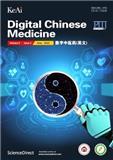| 投稿方式:官网投稿 |
-
更多
期刊简介
- 《数字中医药(英文)》(DigitalChineseMedicine,DCM)(季刊),创刊于2018年,由湖南省教育厅主管,湖南中医药大学、中华中医药学会主办的以促进中医药的国际化、标准化、量化、数字化及创新为特色的全英文学术期刊。本刊旨在报道国内外中医药领域的基础研究和临床应用的原创性成果,以期为疾病诊断、治疗提供新理论、新方法和新证据,为国内外各高等中医药科研、教育机构的相关人员提供学术交流平台,为中医药的发展略尽绵力。投稿范围:中医、中药、针灸相关的理论、临床、实验、技术创新等方面的内容均欢迎。
-
基本信息
- 期刊名称:数字中医药(英文)(Digital Chinese Medicine,DCM)
- 主管单位:湖南省教育厅
- 主办单位:湖南中医药大学、中华中医药学会
- 国内刊号:CN 43-1540/R
- 国际刊号:ISSN 2096-479X
-
- 出刊日期:
- 期刊定价:
-
- 邮发代码:
-
- 所在省区:湖南
- 邮政编码:
- 联系地址:
-
投稿信息
-
- 学科分类:中国医学
- 版面费用:有
-
- 字数要求:4000-32000
- 查重要求:-
-
- 复合因子:0.957
- 综合因子:0.739
-
- 审 稿 费:待核实
- 稿费:待核实
- 本刊可发:
- 特殊属性:
-
联系方式
- 投稿网址:https://www.editorialmanager.com/dcmed/
- 官网网址:http://www.keaipublishing.com/dcmed
- 电话传真:0731-88459415(202404期)
- 电子邮箱:dcm@hnucm.edu.cn(202404期)
- 微信公众号:


